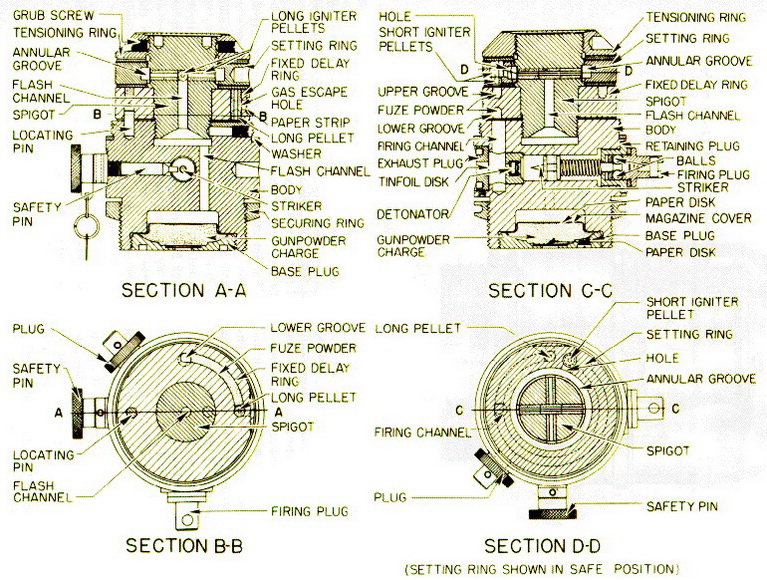|
|
| BRITISH EXPLOSIVE ORDNANCE |
| Part 2 - Chapter 3 |
| Fuzes |
|
Nose Fuze No. 35 Mks I, I*, II, II*, III and IV (Service) |
| Data |
| Bombs used in | 4.5 in reconnaissance flare |
| Action | Pyrotechnical aerial burst |
| Armed condition | When safety pin is removed |
| Fuzes used with | None |
| Arming time | Instantaneous |
| Body diameter | 2.36 in. |
| Over-all length | 3.4 in. |
|
Description: Fuze No. 35 Mk IV consists of a body containing and igniter mechanism, a delay system, a setting ring, magazine charge ingniters, and a magazine holding a gun-powder charge. The igniter mechanism comprises a spring-loaded striker and a detonator located in a horizontal channel in the fuze body. The striker is held in a firing plug by two retaining balls which engage an annular groove of the striker. The firing plug protrudes from the fuze body, and is attached to the aircraft by a fuzing link. A safety pin, scre-wed into the body, retains the striker in the safe position. |
|
The delay system consists of a quantity of delay composition contained in two groo-ves cut into the upper and lower surfaces of the fixed delay ring. A bridge of metal se-parates the ends of each groove, and a long pellet connects the grooves. The powder in the lower groove provides a fixed minimum delay period and communicates with a firing channel located between the detonator and the exhaust plug. The fixed-delay ring is se-cured to the fuze body by a locating pin. Its outer surface is graduated in hundreds of feet up to 800, and thereafter in thousands of feet, representing the distance of fall be-fore the magazine is fired. |
|
The setting ring, on which a red setting arrow is marked, contains two short igniter pellets. A hole leads from the upper pellet to an annular groove formed in the ring. This groove is aligned with an annular groove cut in a spigot, which is screwed into the fuze body. A number of long igniter pellets, arranged in the form of a cross in the spigot, communicate with the groove in the spigot. A flash channel leads down from the center of the cross, through the spigot, and into another flash channel in the fuze body. The latter channel leads to the magazine. A tensioning ring, locked in position with grub screws, determines the ease with which the setting ring may be rotated. |
|
The magazine consists of an apertured magazine cover held in position by a base plug, which is screwed into the bottom of the fuze body. A paper disc covers the aper-ture in the magazine cover, and a hole leading out of the base plug is sealed with anot-her paper disc. The magazine contains a gunpowder charge of about 30 grains. |
|
Operation: The safety pin is removed manually when the flare is loaded aboard the aircraft. The firing plug is withdrawn upon release, pulling back the striker against its spring until the two balls are clear of the retaining plug. The balls then fall away, and the striker is foreced by its spring against the detonator. |
|
The flash passes through the firing channel and ignites the powder in the lower groo-ve of the fixed-delay ring. This fires the long pellet connecting the upper and lower groo-ves, which in turn ignites the powder in the upper groove. After a time interval determi-ned by the position of the short igniter pellets in the setting ring, these pellets are fired by the powder in the upper groove. The flash from the short igniter pellets passes through the hole communicating with the annular grooves in the setting ring and spigot, and ignites the long igniter pellets in the spigot. The flash from these pellets passes, downward through the flash channels in the spigot and the fuze body, and fires the gun-powder charge in the magazine. |
|
Remarks: Fuze No. 35 Mk I is identical to the Mk IV, except that the fixed-delay ring is graduated from 3½ to 17 representing seconds of delay. The magazine contains 50 grains of gunpowder. The No. 35 Mk I* is identical to the Mk I, except that the gunpow-der charge is reduced to 30 grains. The No. 35 Mk II is identical to the Mk IV, except that the gunpowder charge in the magazine is 50 grains. The No. 35 Mks II* and III are substantially identical to the Fuze Mk IV. |
|
|
|
Figure 150 - Nose Fuze No. 35 Mk IV |
 |
|
Figure 151 - Nose Fuze No. 35 Mk IV |